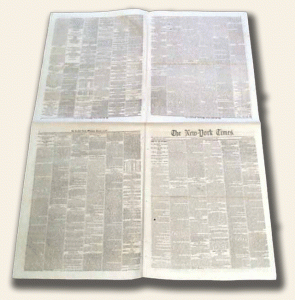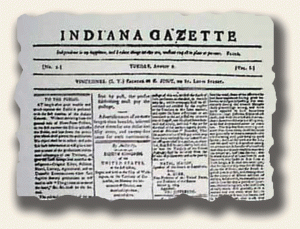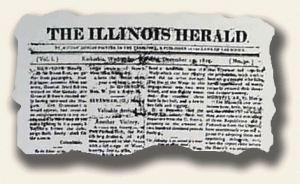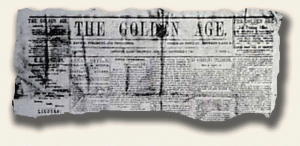The first newspapers in Kansas…
March 30, 2010 by TimHughes · Leave a Comment
The first permanent settlement in Kansas was made at Fort Leavenworth in 1827, but until 1854 when the Kansas-Nebraska Act was passed by congress the region remained a part of the somewhat indefinitely bounded Indian Territory.
Early in 1834, missionary Jotham Meeker set up his printing press–the first press to be used west of the Missouri River–at the Shawnee Baptist Mission in present Johnson County. That year he published hymns, religious tracts, and other materials that were the first items printed in Kansas.
 On February 24, 1835, Meeker printed at the Shawnee Mission the first number of the “Shawnee Sun” (Siwinowe Kesibwi), the first periodical publication in Kansas, and the first printed entirely in a Native American language. The paper was issued at irregular intervals from 1835 to as late as 1844, probably in limited editions of 150 or 100 copies. Measuring about 6 3/4 inches by 10 3/4 inches, the paper had two 8 1/2-inch columns of text per page.
On February 24, 1835, Meeker printed at the Shawnee Mission the first number of the “Shawnee Sun” (Siwinowe Kesibwi), the first periodical publication in Kansas, and the first printed entirely in a Native American language. The paper was issued at irregular intervals from 1835 to as late as 1844, probably in limited editions of 150 or 100 copies. Measuring about 6 3/4 inches by 10 3/4 inches, the paper had two 8 1/2-inch columns of text per page.
The “Shawnee Sun” circulated among the Indians at and near the mission settlement. Today only one copy of one issue is known to have survived–the issue for November 1841, now in the library of the University of Missouri at Kansas City.
The “Kansas Weekly Herald” was established at Leavenworth on Sept. 15, 1854 by William Osborn and William Adams. It was a truly pioneer enterprise as is evidenced by the fact that the town site was occupied only by four temporary tents. The editor in his first number noted: “Our editorials have been written and our proof corrected while sitting on the ground with a big shingle for a table.”
Another newspaper was begun in Kickapoo, Kansas, in 1854 titled the “Pioneer“, and a year later the first newspaper at Topeka was established, the “Kansas Freeman“.
The first newspapers in Iowa…
March 22, 2010 by TimHughes · 1 Comment
The state of Iowa had various “owners” over the last 300+ years. It became a French possession in 1682, in 1762 was ceded to Spain, in 1800 it was returned to France, who in 1803 passed ownership to the United States under the terms of the Louisiana Purchase.
 In 1804-5 as part of the District of Louisiana it was under the government of the Indiana Territory. During the next seven years it was in the Missouri Territory, and from 1821-34 it was a part of the unorganized territory of the United States. From 1834-6 it was part of the Michigan Territory, and from 1836-8 a part of the Wisconsin Territory. In 1838 the Wisconsin Territory was divided & the western portion was named the Iowa Territory, which in 1846 was admitted as a state.
In 1804-5 as part of the District of Louisiana it was under the government of the Indiana Territory. During the next seven years it was in the Missouri Territory, and from 1821-34 it was a part of the unorganized territory of the United States. From 1834-6 it was part of the Michigan Territory, and from 1836-8 a part of the Wisconsin Territory. In 1838 the Wisconsin Territory was divided & the western portion was named the Iowa Territory, which in 1846 was admitted as a state.
The first printing in the district was in 1836 when John King, who moved from Ohio to Dubuque, believed the town should have a newspaper and on May 11, 1836 began printing the “Visitor“, the first newspaper in Iowa. A year later the name changed to the “Iowa News“, and 4 years later to the “Miners’ Express“. Iowa’s second newspaper was the “Western Adventurer and Herald of the Upper Mississippi” (not sure how they fit that in the masthead) begun by Dr. Isaac Galland on June 28, 1837 in Montrose. It lasted for just a few months when the equipment was sold to James Edwards who took it to Fort Madison & on March 24, 1838 the first issue of the Fort Madison “Patriot” was published.
Uncut newspapers: leave as they are?
March 20, 2010 by TimHughes · 1 Comment
 Fellow collector Morris Brill poses an interesting question worth sharing with others, along with my thoughts on the issue.
Fellow collector Morris Brill poses an interesting question worth sharing with others, along with my thoughts on the issue.
I suspect we have all encountered “uncut” newspapers from the 19th century, issues which are eight pages in length but which are essentially one large sheet of paper printed on both sides, then folded twice to produce the eight pages. This is how they came off the printing presses . Morris inquires:
“For the sake of maintaining the monetary value of such a newspaper is it best to leave the paper in this one piece condition or is it best to cut the paper so it folds normally like a book and the pages can be turned individually?”
Uncut issues are, for the most part, those which have survived the years by not being bound, kept loose by previous owners and eventually finding their way into the hands of collectors. Given that the vast majority of early newspapers in the collector market came from bound volumes once stored by libraries or other institutions then “disbound” into individual issues, uncut newspapers are relatively few in number. Once bound all margins, save for the spine, are guillotined at the bindery to produce an even, book-like edge thus losing the attachment at the top.
Since uncut issues are newspapers in the original state, as they were sold on the streets, my preference would be to keep them as such. Most collectibles tend to be more desirable in their original state: never clean an old coin; never paint an antique wagon; don’t removed the aged patina from an antique desk, etc. Are such newspapers more clumsy to read? Yes, to some degree. But they can be folded back and all 8 pages read with little difficulty. It’s obviously how it was done years ago as I’ve purchased several boxes of uncut 19th century newspapers which were folded many different ways, left as such by the reader.
They only time I might suggest cutting the top of an uncut sheet is the rare occasion when an issue was bound, causing all four leaves to be attached at the spine, yet the tops have not been trimmed. In such situations the newspaper cannot be folded back because of the attachment at the spine. I would take an exacto knife and cut the very top along the fold. Not much else can be done if the interior pages are to be read.
Collectors may have noticed that we charge a small premium for uncut newspapers. A downside to an uncut issue is they tend to be more worn than those bound as they have not been protected through the years by the bindings, but if one can obtain an issue which is both uncut and in great condition–and contains the Gettysburg Address–there’s a great item for any collection!
Featured websites – TeachHistory.com
March 18, 2010 by GuyHeilenman · Leave a Comment
 Teachers with a love of history, listen up! The following resource can improve your curriculum and make you a stronger educator. Students of history will enjoy the breadth and depth of the historical journey as well.
Teachers with a love of history, listen up! The following resource can improve your curriculum and make you a stronger educator. Students of history will enjoy the breadth and depth of the historical journey as well.
TeachHistory is a fantastic website (blog), developed and maintained by Ben Edwards, which provides engaging information & a plethora of useful educational resources related to history. It describes itself as:
“a blog dedicated to social studies and history teachers across the United States who use Colonial American history, imagination and multisensory teaching methods to inspire their students. Our goal is to provide a resource where teachers like you can access information about colonial history plus technologies, methods and products that are making a difference in education today.”
While Ben’s experience with teachers and students is varied, perhaps the most useful channel for keeping him in touch with the pulse of teacher/student interests and needs occur via the many intimate conversations had while engaging teachers and students through his Walking Tours of Historic Boston. Combine this with both his (historic) heritage and his natural love of history, and you have the making of a blog which is sure to stay relevant over time. Some of the recent posts include:
Colonel Shaw, Sergeant Carney and the 54th Massachusetts
Remembering Alex Haley and Roots
Black History Month: A Tribute to Phillis Wheatley
Young Ben Franklin and the Silence Dogood Letters
Teachers: Are You Engaging AND Empowering Your Students?
Many of the posts include detailed images and reference accounts of actual Rare & Early Newspapers – most of which come from his personal collection. Ben fully grasps a foundational truth regarding primary sources: “History is never more fascinating than when it is read from the day it was first reported.” Thanks Ben, for your contributions to both the Rare Newspapers and Educational communities.
Indiana’s first newspapers…
March 15, 2010 by TimHughes · Leave a Comment
Indiana was the first state to be named after America’s original inhabitants, meaning “land of Indians”. When the Indiana Territory was created in 1800 it encompassed all of the present states of Illinois & Wisconsin, nearly all of Indiana, and parts of Ohio, Michigan, and Minnesota.
 In Vincennes in 1804 Elihu Stout, a Virginian, printed the first number of the “Indiana Gazette“, the first newspaper in Indiana. It continued until 1806 when the establishment was destroyed by fire. Stout purchased a new printing outfit and on July 4, 1807 he resumed publication under the new name of the “Western Sun“.
In Vincennes in 1804 Elihu Stout, a Virginian, printed the first number of the “Indiana Gazette“, the first newspaper in Indiana. It continued until 1806 when the establishment was destroyed by fire. Stout purchased a new printing outfit and on July 4, 1807 he resumed publication under the new name of the “Western Sun“.
It was the custom, and a natural one, for printers, in seeking new locations, to choose towns with promise of a prosperous future. In the undeveloped western wilderness such towns were believe to be only those located on navigable rivers. Such towns as Madison saw the start of the “Western Eagle” in 1813, and tow town of Corydon had its “Indiana Herald” begin in 1816; Vevay had the “Indiana Register” by 1816, and Brookville had the “Plain-Dealer” also by 1816.
Yes, he’s dead again (but not really)…
March 13, 2010 by TimHughes · 1 Comment
Given that newspaper reporting from the 18th and 19th centuries was as much hearsay as factual, it was not uncommon for many reports to be refuted in the same newspaper a few days later. This included deaths as well. I suspect all of us collectors have found false reports deaths of someone notable.
The “New York Tribune” was not immune to this problem, and even seemed to make light of it in their front page headlines when they reported the Battle of Antietam in their Sept. 20, 1862 issue. Among the heads is “Stonewall Jackson Dead Again” (see photo). But they only rubbed salt in their own wound—he (Stonewall Jackson) actually didn’t die until seven months later, the result of being shot at the battle of Chancellorsville (by one of his own soldiers).
Featured websites – RagLinen.com
March 11, 2010 by GuyHeilenman · Leave a Comment
 From time to time we like to take a look at various websites which may enhance our Timothy Hughes Rare & Early Newspapers‘ members collecting experience. Todd Andrlik’s “Rag Linen“, is such a site. It describes itself foremost as “…an educational archive of rare and historic newspapers, which serve as the first drafts of history and the critical primary source material for historians, authors and educators.” A sample of Rag Linen’s posts on the corresponding blog include:
From time to time we like to take a look at various websites which may enhance our Timothy Hughes Rare & Early Newspapers‘ members collecting experience. Todd Andrlik’s “Rag Linen“, is such a site. It describes itself foremost as “…an educational archive of rare and historic newspapers, which serve as the first drafts of history and the critical primary source material for historians, authors and educators.” A sample of Rag Linen’s posts on the corresponding blog include:
- A Short Narrative of the Horrid Massacre in Boston
- B. Franklin’s Confession to Leaking Hutchinson’s Letters
- Paul Revere’s “View of the Year 1765″
- The Stamp Act Teaser of 1764
- The Great Scottish Witch Hunt of 1661-1662
- The 12 Letters That Preceded The Burr-Hamilton Duel
- The Original Flag of the Thirteen United States
- Three Cheers for Lincoln’s Gettysburg Address
- An Unlikely Spy Embedded as a Newspaper Printer
- The Real First President of the United States
Rag Linen also has useful information on the History of Newspapers, the Condition & Preservation of newspapers, and more. Well done Todd. Thanks for your contributions to the rare newspapers community.
First newspapers in Illinois…
March 8, 2010 by TimHughes · 1 Comment
Kaskaskia, a thriving town on the Mississippi River and the territory’s first capital, was the place of the first printing done in Illinois while it was still a territory.  Mathew Duncan, a printer who had moved from Kentucky, began publication of Illinois’ first newspaper, the “Illinois Herald” in 1814. The name would change to the “Western Intelligencer” in 1816, and again to “Illinois Intelligencer” in 1818. Two years later it would be moved to Vandalia which had become the capital of the state.
Mathew Duncan, a printer who had moved from Kentucky, began publication of Illinois’ first newspaper, the “Illinois Herald” in 1814. The name would change to the “Western Intelligencer” in 1816, and again to “Illinois Intelligencer” in 1818. Two years later it would be moved to Vandalia which had become the capital of the state.
The second newspaper in Illinois was the “Illinois Emigrant” which began on June 13, 1818 at Sawneetown. A year later the title was changed to the “Illinois Gazette”.
The first newspaper in Chicago was a weekly paper titled the “Chicago Democrat“, which began on Nov. 26, 1833.
It caught my eye…
March 6, 2010 by TimHughes · Leave a Comment
The front page of the “Weekly Missoulian” newspaper from Missoula, Montana Territory, December 12, 1873 has an article titled: “The Value of a Newspaper” which logically caught my eye. Although the item had nothing to do with the value of an historic newspaper, it does say much about the relative cost to subscribe to a newspaper in the 1870’s, and has a nice story associated with it as well. Enjoy.
I have typically found Old West newspapers to have some of the more interesting tidbits of any era or region. We have hundreds to choose from for your browsing.
First newspaper in Idaho…
March 1, 2010 by TimHughes · Leave a Comment
Idaho’s name was adapted from the Shoshone Indian call, “Ee-dah-how!”. Its literal translation is “Look! The sun is coming down the mountain.” It was a part of the “Oregon Country” claimed by Spain until 1819 and by Russia until 1824. Great Britain and the United States held it jointly until Britain relinquished her claim to the United States by treaty in 1846.
 In 1839 the American Board of Foreign Missions brought back from Hawaii the printing outfit that had been sent there in 1821 (see our post for Feb. 22: “Hawaii’s first newspapers…”) and transferred it to Idaho. In 1862 in Lewiston, named after explorer Meriwether Lewis, Idaho’s first newspaper, the “Golden Age”, was established by A. S. Gould who hasd previous printing exerience in California and Oregon. The “Golden Age” was discontinued in 1865 when the printing press was moved to Leesburg. In 1867 the “Mining News” was established but the printer was able to keep it going for only eight months.
In 1839 the American Board of Foreign Missions brought back from Hawaii the printing outfit that had been sent there in 1821 (see our post for Feb. 22: “Hawaii’s first newspapers…”) and transferred it to Idaho. In 1862 in Lewiston, named after explorer Meriwether Lewis, Idaho’s first newspaper, the “Golden Age”, was established by A. S. Gould who hasd previous printing exerience in California and Oregon. The “Golden Age” was discontinued in 1865 when the printing press was moved to Leesburg. In 1867 the “Mining News” was established but the printer was able to keep it going for only eight months.
The first newspaper in southern Idaho (3nd in the territory), the “Boise News” was started on Sept. 29, 1863 at Idaho City, and the fourth newspaper, the “Idaho Tri-Weekly Statesman” began printing on July 26, 1864 in Boise.




